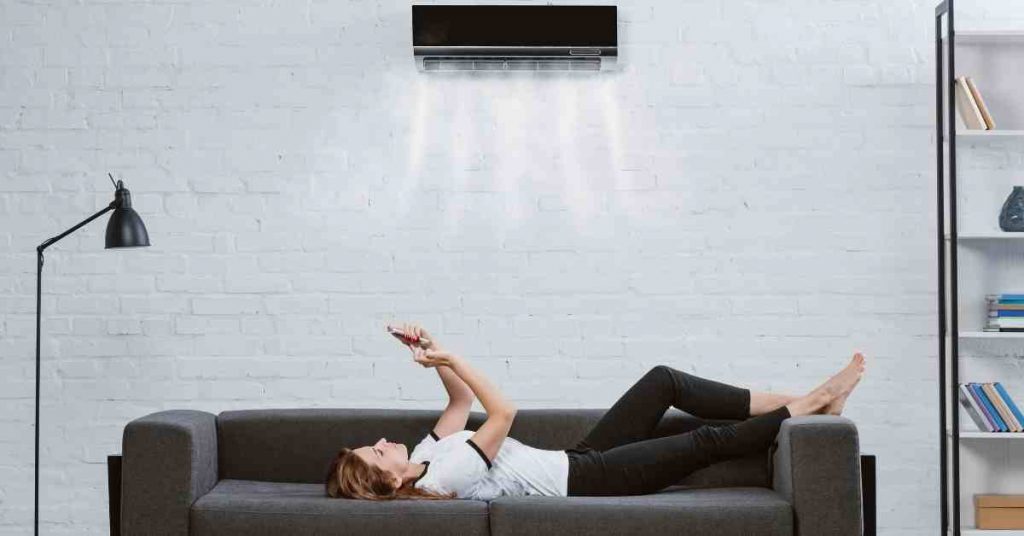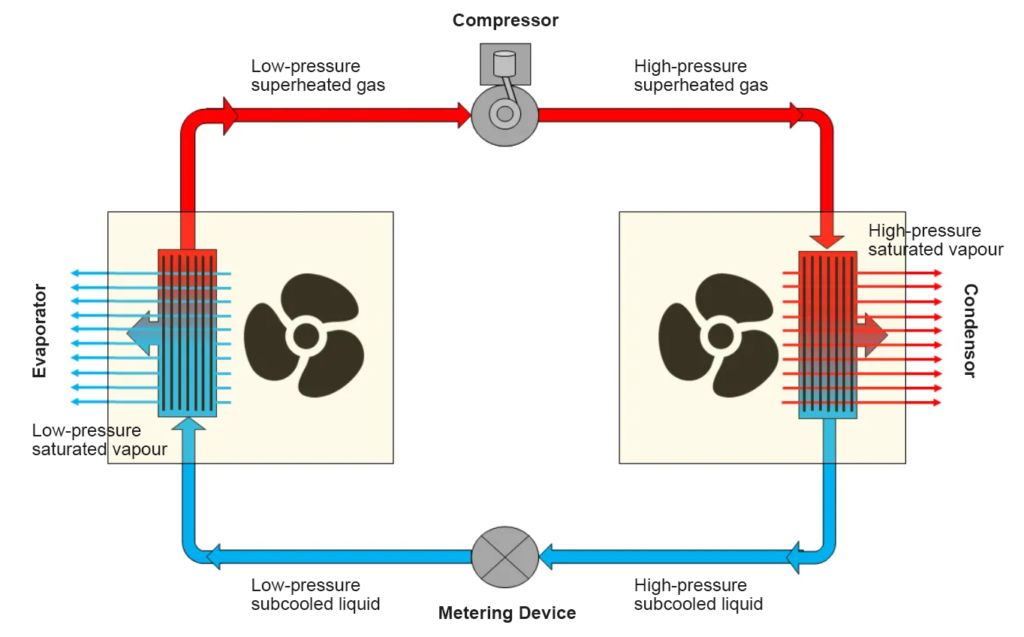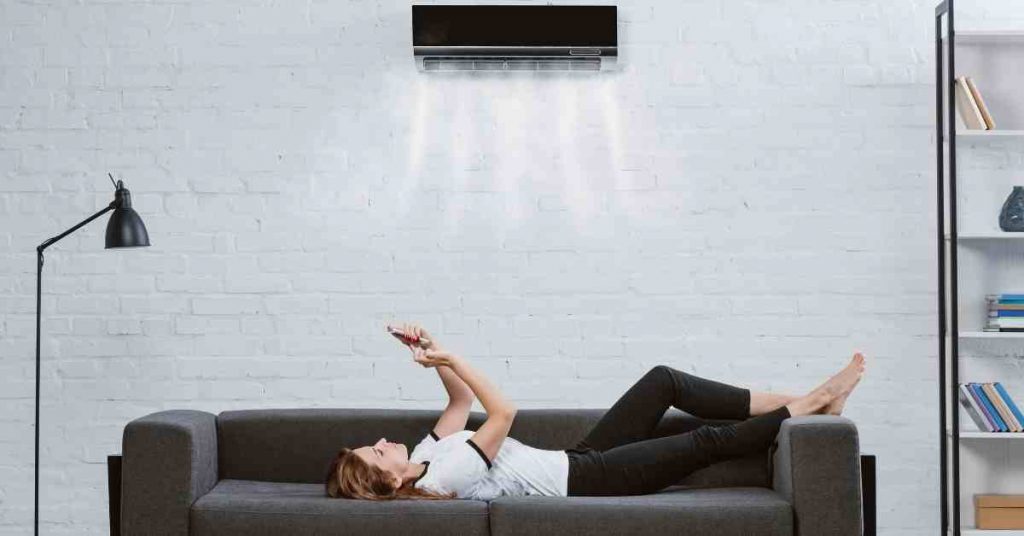
Ever wondered how an Air Conditioner works?
Here’s a brief step-by-step guide on how an air conditioner works:
- Air Intake: The air conditioning process begins when warm indoor air is drawn into the system through the return air ducts.
- Filtering: Before the air is cooled, it passes through a filter that removes dust, particles, and allergens, improving indoor air quality.
- Cooling Coil: The filtered air then flows over a cooling coil containing a refrigerant, typically a chemical compound like R-410A or R-22.
- Refrigeration Cycle:
- The refrigerant in the cooling coil absorbs heat from the warm indoor air, causing it to evaporate and turn into a gas.
- The warm refrigerant gas is then compressed by a compressor unit, increasing its temperature and pressure.
- The high-pressure, hot refrigerant gas is circulated to the outdoor unit, where it releases heat to the outside air through a condenser coil.
- As the refrigerant loses heat and pressure, it condenses back into a liquid state.
- Expansion Valve: The high-pressure liquid refrigerant passes through an expansion valve, where it undergoes a rapid drop in pressure, causing it to cool significantly.
- Cool Air Distribution: The now-cooled refrigerant flows through the evaporator coil, and a fan blows warm indoor air over the coil.
- Heat Exchange: The indoor air’s heat is absorbed by the cold refrigerant in the evaporator coil, cooling the air.
- Circulation: The cool air is then distributed throughout the building through a system of ducts, vents, and registers.
- Thermostat Control: The air conditioner’s thermostat continuously monitors the indoor temperature and adjusts the cooling process to maintain the desired temperature setting.
- Cycling: The air conditioner cycles on and off as needed to maintain the set temperature. When the indoor temperature rises above the desired level, the system restarts to cool the air again.
- Moisture Removal: As a byproduct of the cooling process, air conditioners also dehumidify the air by condensing moisture from the indoor air onto the evaporator coil. This helps improve indoor comfort by reducing humidity levels.
- Outdoor Unit: The outdoor unit of the air conditioner houses the compressor, condenser coil, and a fan. It expels the heat collected from indoor air into the outdoor environment.

From, the above, explanation, you learn that both the evaporator coil and condenser coil are heat exchangers. Inside the condenser coil, the refrigerant loses heat to the surrounding and is thus converted from gas to liquid.
Inside the evaporator coil, the refrigerant absorbs heat from the warm air inside the house and is converted from liquid to gas.
The guiding principle in air conditioning is that heat is transferred from a point of high concentration to a point of low concentration. Both the evaporator and condenser fans are merely there to speed up the process.
How an Air Conditioner Works
Let us now dive deeper and look at the step by step processes of how air conditioning works in your house. As earlier mentioned, there are 2 units in air conditioning, one located inside the house and the other one located outside.
We will start with outside air conditioning unit also known as the outdoor unit or the hot side.
1. Compressor
In simple terms, a compressor is merely a pump that squeezes air together and ejects it out under high pressure. Since air conditioning works very much like the human body, the compressor is the equivalent of the heart.
The refrigerant coming from the evaporator coil inside the house is low-pressure and high-temperature vapor/gas. It enters the compressor as such but it exits as a high-pressure high-temperature gas.
But how is that possible and why is a compressor important anyway?
When you compress a gas, its pressure increases. That is because the gas particles are now close together and contained in a smaller surface area.
Increase in the pressure of a gas also results in an increase in temperature. The gas particles are close together and therefore colliding with each other at a faster rate than before and hence the increase in temperature as well.
It is like rubbing your palms together. The faster you do it the more the friction and hence the more heat is generated.
As I had mentioned before, the condenser coil is a heat exchanger. The gas inside the compressor contains heat from the evaporator coil inside the house which you need to remove to the surrounding.
But you also need to remember that heat is transferred from a point of high concentration to a point of low concentration.
By compressing the gas from the evaporator coil and increasing its pressure and temperature, you will have ensured that heat will be transferred from the refrigerant gas to the surrounding.
Older air conditioners use a reciprocating compressor which comprises of a piston very much like the ones found in a combustion engine.
When the piston moves up in the cylinder, low pressure and temperature refrigerant gas from the evaporator coil enters the compressor. As the piston starts to move down, the gas is compressed together and is ejected out to the condenser coil under high pressure and temperature.
Modern air conditioners however use what is known as the scroll compressor. A scroll compressor is operated by a motor and has more advantages of over the reciprocating motor the main ones being its high precision compressing and compact size.
Scroll compressor comprises of 2 scrolls whereby one is stationary while the other one is free to rotate.

When air enters and as it moves through the scrolls, the surface area becomes smaller and is therefore compressed and exits through the center of the scroll as a high-pressure high-temperature gas.
The speed of the motor can be easily controlled to ensure cooling is precisely achieved as desired.
2. Condenser Coil
To understand the function of a condenser, you must first understand the mean of the word condensation.
In simple terms, condensation is the process where vapor becomes liquid. In the case of air conditioning, a condenser coil is the component where the refrigerant changes from vapor/gas to liquid.
Condensation is the reason our car windows become foggy when it is very cold outside. Warm air from our breath comes into contact with the cold glass and it is converted from gas to liquid.
As I mentioned above, the temperature of the refrigerant needs to be higher than that of the surrounding air for there to a beat a heat exchange. This is exactly why the refrigerant enters the condenser as a hot high-pressure vapor.
It is also the reason that both the condenser coil and the compressor are installed outside the house.
The condenser is made up of a copper tube that is coiled back and forth. Hot vapor under high pressure enters the condenser coil at the top and exits as cold liquid at the bottom.
As the refrigerant moves through the condenser coil, a fan blows air through the coil which takes with it most of the heat. The outside of the condenser coil has metal fins similar to those of a car radiator which helps to dissipate the heat faster.

And do you know why the condenser is made of copper tubes that are coiled back and forth? Well, it increases the surface area of the refrigerant in contact with the cooler air being blown over by the fan.
Every time the refrigerant moves through the tubing, it will lose heat to the surrounding and by the time it is exiting the condenser coil it will be almost in liquid form.
3. Expansion Valve
An expansion valve is a small opening through which refrigerant from the condenser coil enters the evaporator coil. But why do we need an expansion valve? What is its function?
Although you cannot see it, the expansion valve is located inside the house in the same assembly as the evaporator coil. The evaporator coil, compressor and condenser are connected together using copper tubes which form a closed-loop system.
As I mentioned earlier, when you increase the pressure of a gas, the temperature also increases. The opposite is also true.
Remember that the almost-liquid refrigerant from the condenser is under high pressure but also not as cold as we would like it to be.
And that is where an expansion valve comes in. The copper tube carrying the refrigerant from the condenser is forced to go through the expansion valve which is basically a small hole/opening/restriction.
Think of an expansion valve like the spray nozzle on a spray bottle.

When the refrigerant emerges on the other side of the valve/restriction, its pressure will drop considerably, and likewise the temperature will also reduce drastically.
And that is the main function of the expansion valve: to control the amount (pressure) of refrigerant from the condenser to the evaporator coil.
Although it is a small part of the whole system, it is very important because if it is faulty, the whole system will not work as intended.
Inside the evaporator coil, the liquid refrigerant needs to be converted back to gas/vapor before going back to the compressor. If that does not happen, liquid refrigerant will get to the compressor and that will definitely damage it.
As such, if the expansion valve allows too much refrigerant inside the evaporator coil, not all of it will vaporize meaning some liquid will still enter the compressor. And we don’t want that. It will also result in overcooling.
On the other hand, if the expansion valve does not allow enough refrigerant into the evaporator coil, the system will be ineffective since it will be enable to remove all the heat from the house.
In older units, the expansion valves were very simple. There was a fixed orifice on the expansion valve. This means that the size of the opening does not change at all.
As you can imagine, air conditioners with this type of expansion valves were not very effective. To control the amount of refrigerant getting into the evaporator coil, they kept turning on and off.
For proper cooling to take place, the size of the orifice needs to change as the cooling demands changes.
A thermostatic expansion valve, commonly known as a TXV came in to rectify this problem. So, how does a thermostatic expansion valve work?

A TXV uses a bulb that is fitted at the end of the evaporator coil where the refrigerant exits it to enter the compressor. The bulb sends a signal to the TXV to open wider when the temperature of the refrigerant exiting the evaporator is high, and to restrict inflow of refrigerant when the temperature drops (signifying presence of liquid).
Thermostatic expansion valves are only calibrated and adjusted by approved technicians so mistakes are likely to happen although to very frequently.
The latest invention of expansion valves are the electronic expansion valves. These use a controller to measure the exact temperature and pressure and automatically adjust the valve position.
4. Evaporator Coil
The actual cooling process in your house happens around the evaporator. It is important to however remember that the whole process is however initiated by a thermostat.
A thermostat is usually installed inside the house in a central position and is responsible for monitoring, starting and stopping the air conditioning system.
When the air inside your house starts to warm up, the thermostat communicates with the other components of the air conditioner and they start running.
Just like an condenser coil, to understand what happens inside the evaporator coil, you need to first define evaporation. Evaporation is the process through which liquid turns into gas/vapor.

For a liquid to turn from liquid to vapor, it needs to be supplied with heat. The heat in this case will come from the house. So here we have a cold refrigerant inside the evaporator coils and warm air from the house.
Heat exchange will happen between the refrigerant and the surrounding warm air. At the end of the process, the refrigerant will be heated and converted to vapor, a process which will cool the air surrounding the coil.
It is very much like sweating. As the sweat vaporizes from our skin a cooling effect is created.
This is why a refrigerant with a low boiling point is preferred. As such, it is able to change from liquid to gas easily.
To help with the cooling, a fan is used suck in hot air from the house, blow it over the evaporator for heat exchange to occur and then dissipate the cooled air back to the different spaces through a network of ducts.
The evaporator fan unlike the condenser fan looks like a cylinder (to economize on space) and is referred to as an impeller fan.
When the thermostat sends a signal to the air condition units to start running, the evaporator fan sucks the warm air from the rooms using return air ducts. The air passes through filters where it is cleaned (to remove dust, lint and other forms of dirt).
Most evaporator coils looks like the letter “A” but you can still get some looking like “N” or even “W”. All this is to increase the number of coils and therefore the area of cold refrigerant in contact with warm air for efficient cooling to take place.
After the refrigerant has vaporized, it is sent back to the compressor through copper tubes as a low-pressure gas for the whole process to start again.
Cold air is then distributed to the various spaces around the home through the ductwork network.
Types of Air Conditioners
While the principle of air conditioning remains the same, homes are very different. For instance, a tiny cabin or a container home will have very different cooling demands as a 10-bedroom residential unit.
As such, there are different types of air conditioners each designed to suit a particular type of need. The following are the main types of air conditioners:
1. Split-System Air Conditioners
Central air conditioners or known as split-system air conditioners are what you will find in most homes in North America. They comprises of the outdoor unit (condenser and compressor) and an indoor unit (the evaporator coil).
Split-system air conditioners are quiet, energy-efficient and provide consistent cooling throughout the house. Apart from just cooling, the air conditioner also cleans the air inside the house (thanks to the filters).
2. Packaged Air Conditioners
Unlike split-system air conditioners, packaged air conditioners contain the compressor, condenser coil, evaporator coil and blower fan all in one unit.
The common thing between these types of air conditioners and split-system air conditioners is that they suck in air to the evaporator coils using airducts. After heat exchange between the refrigerant and the warm air, the now cooled air is blown back to the living areas through the supply ducts.
Packaged air conditioners can also be classified under central air conditioners.
3. Ductless Air Conditioners
As their name implies, ductless air conditioners have no airducts and cannot therefore be classified under central air conditioners. They are installed to provide cooling to a certain specific area of the house.
Since you don’t need ductwork to install these types of air conditioners, the installation process is fast and less invasive.
The common thing between split-system and ductless air conditioners is that they comprise of an outdoor unit and a at least one inside unit connected using copper tubing. It is not uncommon to have several indoor units connected to one outdoor unit.
The indoor units can be installed on the wall, floor or even ceiling.
The main advantage of these air conditioning systems is unlike in split-system where the whole house is set to the same temperature, you can opt to have different temperature settings for different rooms as need be.
Having problems with your Air Conditioner? You can always get a free quote from a local HVAC company below:






